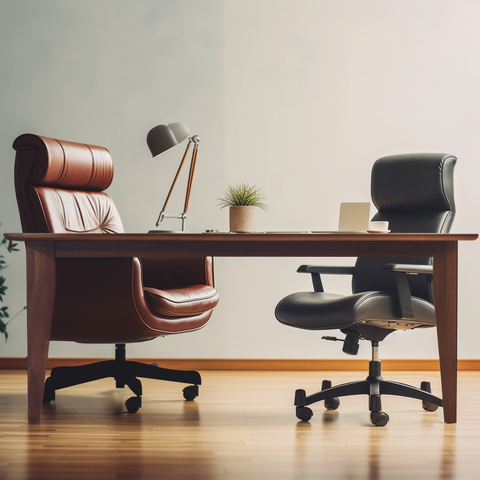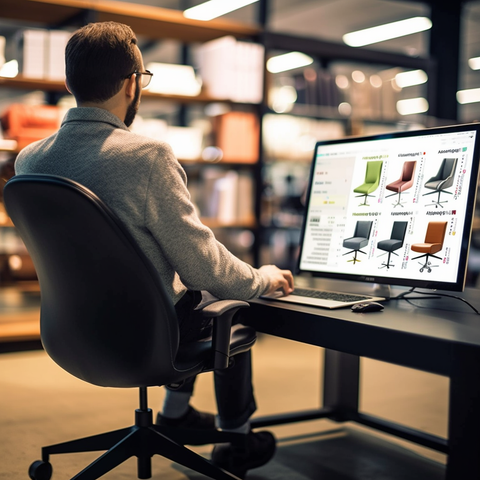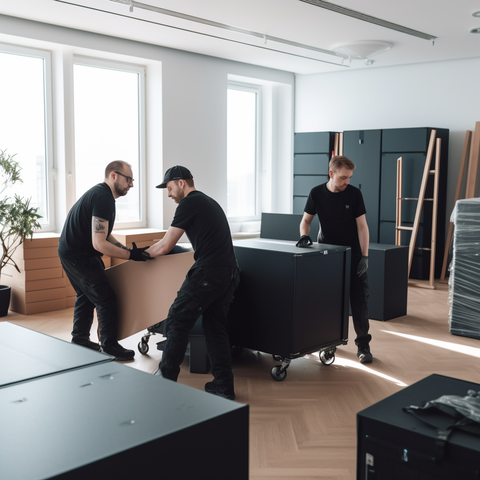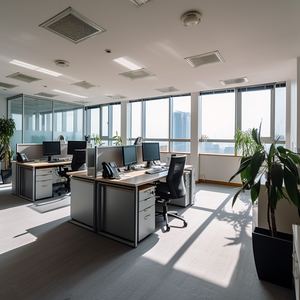Introduction
This is a very long read, if you simply want to buy some used office furniture, please click on links below:
Welcome to our comprehensive guide on buying second-hand office furniture! With the rise of remote work and startups, creating a comfortable and efficient workspace has never been more important. While many are tempted to rush off to buy brand-new office furniture, there's a thrifty, and often overlooked, option at your disposal - second-hand furniture. Choosing second-hand office furniture can be a smart decision for several reasons. It's not only friendly to your wallet, but also to the environment, as it reduces demand for new products and keeps perfectly good furniture out of the landfill. Plus, you can find unique, quality pieces with a bit of history, or snag high-end brands at a fraction of the original cost. However, buying second-hand requires a different approach than buying new. How do you spot high-quality furniture? What questions should you ask the seller? And where do you even find second-hand office furniture? If you're navigating these questions for the first time, it might feel a bit overwhelming. That's where this guide comes in. We're here to walk you through the entire process, from recognizing your office's furniture needs to negotiating prices and avoiding common pitfalls. By the end of this guide, you'll be equipped with the knowledge and confidence to find great second-hand office furniture that suits your needs and budget. So, let's get started on this journey to sustainable, cost-effective office furnishing!
If you don't want to become expert at second hand office furniture yourself, you can simply talk to one of our experts. Just call us for free on 0800 6522 809 and we will help you find what you need.
Recognizing the Need for Office Furniture
Before diving into the second-hand furniture market, it's crucial to first understand your own office furniture needs. Buying second-hand furniture can be an exciting treasure hunt, but it's easy to get carried away and purchase items that look great but don't necessarily serve your needs.
Start by considering the space you have available. Measure the dimensions of your office or workspace to understand what size furniture will fit comfortably. You'll want to ensure there's enough space for movement around the furniture, especially in high-traffic areas. Take note of any potential obstructions like radiators, windows, or pillars that might affect furniture placement.
 When an office is lacking in furniture, workers could be lacking in productivity.
When an office is lacking in furniture, workers could be lacking in productivity.
Next, think about how many employees you have or plan to have. Does each employee need a desk, or will some be working remotely? Do you need shared workstations or individual desks? What about meeting rooms — will you need a conference table and chairs, or can meetings be held in a more casual setting with sofas and coffee tables?
Reflect on the style of your office as well. Is your office environment formal or casual? Modern or traditional? Do you want to project a specific image to visitors or clients? Your furniture can contribute significantly to the overall vibe and aesthetic of your office.
Compile a list of the essential furniture pieces that you need. Common items include desks, office chairs, filing cabinets, storage units, meeting tables, and guest seating. Depending on your office, you might also consider bookshelves, whiteboards, lounge furniture, or standing desks.
Lastly, don't forget to consider the comfort and ergonomics of your furniture. Office furniture is where you and your employees will spend a significant part of your day, so it should promote comfort, productivity, and health. Look for features like adjustable chairs, wrist-supporting keyboards, and monitors that can be set at eye level.
By understanding your office's furniture needs, you'll be able to shop second-hand more strategically, focusing on finding quality pieces that meet your specific requirements rather than getting sidetracked by items that simply look appealing.
Planning and Budgeting
With a clear understanding of your furniture needs, the next step is to plan and budget. Buying second-hand furniture can yield significant savings, but it still requires thoughtful financial planning.
First, set a realistic budget for your office furniture. This budget should be based on the list of essential furniture items you've compiled. If you're unsure about pricing for second-hand furniture, do some preliminary research on online marketplaces or local thrift stores to get a general idea.
Consider the quality and longevity of the furniture you're planning to purchase. It might be tempting to go for the cheapest options, but remember the old saying: "buy cheap, buy twice." It's often better to invest a bit more in high-quality items that will last, rather than cheaper items that might need to be replaced quickly.
Remember to account for unexpected or additional costs. For example, if you're buying furniture online, there might be shipping fees. Some second-hand furniture might need minor repairs or cleaning, adding to the initial cost. And if the furniture is large or heavy, you might need to hire professional movers.
 Used office furniture can provide significant savings.
Used office furniture can provide significant savings.
Think about timing as well. If your office isn't set up yet, where will you store your purchases until it is? Will there be any storage costs involved? And if you need furniture immediately, be aware that hunting for the perfect second-hand pieces can take a bit of time. If you're under a tight deadline, you may need to allocate a higher budget to quickly buy what's readily available.
Lastly, keep track of your expenses as you start buying. It's easy for small purchases to add up without realizing it. By consistently monitoring your expenses, you can ensure you're staying within your budget and making wise financial decisions.
By carefully planning and budgeting, you can maximize the benefits of buying second-hand furniture and create a comfortable, efficient workspace without breaking the bank.
Understanding the Worth of Second-Hand Office Furniture
One of the key elements of successful second-hand shopping is understanding the value of the items you're considering. This involves recognizing the factors that can influence the worth of second-hand office furniture.
The first factor to consider is the brand. Certain office furniture brands, such as Herman Miller, Steelcase, or Knoll, are renowned for their quality and durability. Their pieces often retain value quite well. If you stumble upon furniture from these brands, it might be priced higher than other second-hand furniture, but the quality will likely make it worth the investment.
The condition of the furniture is another major factor. Even the best furniture can become nearly worthless if it's in poor condition. Look for signs of wear and tear such as scratches, dents, or stains. Check the functionality of drawers, doors, or adjustable parts. However, remember that minor cosmetic issues can often be repaired, while structural problems or significant damage can be more problematic.
The age of the furniture can also play a part in determining its value. Vintage pieces with a desirable style can be worth quite a bit. However, older furniture might not conform to modern ergonomic standards, which could affect its value, especially in an office setting.
The market demand is another aspect to consider. The value of a piece of furniture can fluctuate based on trends and consumer demand. A style that's currently in vogue might command higher prices, even if the furniture itself is quite common.
 New and used office furniture is often distinguishable only by the price tag.
New and used office furniture is often distinguishable only by the price tag.
Finally, consider the original price of the furniture. High-end office furniture tends to depreciate less than budget furniture, largely due to its superior quality and durability.
Understanding these factors can help you gauge the worth of second-hand office furniture and ensure you pay a fair price. Remember, the goal is to find a balance between cost, quality, and your specific needs. Buying second-hand allows you to find this balance and create an office space that's both functional and financially savvy.
Where to Buy Second-Hand Office Furniture
Now that you've established your needs, set your budget, and understand how to evaluate second-hand furniture, let's explore where you can find these pieces. Both online and offline markets offer a wide variety of options. Here's a rundown of some of the best places to start your search:
Online Marketplaces
-
eBay: One of the world's largest online marketplaces, eBay offers an impressive array of second-hand office furniture from sellers around the globe. With a convenient search and filter system, you can find exactly what you're looking for from the comfort of your own home.
-
Gumtree: Particularly popular in the UK, Australia, and South Africa, Gumtree is a fantastic online classifieds platform. It features a wide variety of local second-hand office furniture listings, ranging from modern ergonomic chairs to classic wooden desks.
-
Facebook Marketplace: Offering an easy way to buy and sell within your local community, Facebook Marketplace provides a more personal alternative. The platform allows you to view the profiles of sellers, providing an additional layer of trust and security.
-
Online Used Office Furniture Dealers: Several online retailers specialize in second-hand office furniture. These websites often carry a range of items, from individual pieces to entire office sets. Some even offer delivery services, taking the hassle out of transporting larger items. Examples of these retailers include Office Resale, Rework, and Second Hand Office Furniture Co.
Each of these platforms offers a unique buying experience and a broad selection of second-hand office furniture. By exploring these diverse sources, you can compare prices, styles, and quality to find the best pieces for your workspace.
Offline Markets
-
Thrift Stores: Stores like Goodwill or Salvation Army often have office furniture at very affordable prices. The selection varies, but with some patience, you can find some real gems.
-
Garage and Estate Sales: These can be a treasure trove of quality second-hand furniture. Check your local listings for upcoming sales.
-
Auctions: Both traditional and government surplus auctions can have a wide variety of office furniture. Check local auction houses or your local government's surplus property division.
-
Office Liquidations: When businesses close or remodel, they often sell off their office furniture. These can be a great place to find matching sets of desks, chairs, and other office furniture.
-
Flea Markets: While they're more hit-or-miss when it comes to office furniture, you never know what you'll find at a flea market.
Each of these options has its own pros and cons, and what works best will depend on your specific needs, budget, and location. By exploring a variety of sources, you'll increase your chances of finding quality second-hand office furniture that fits your workspace perfectly.
 Shopping for office furniture online is certainly a timesaver, but it has it's downsides.
Shopping for office furniture online is certainly a timesaver, but it has it's downsides.
Online vs. In-person Shopping
When shopping for second-hand office furniture, you'll likely find yourself deciding between online marketplaces and physical stores or sales. Both methods have their advantages and potential drawbacks, and the best choice often depends on your specific needs and circumstances. Here's a comparison to help you make an informed decision:
Online Shopping
Advantages:
- Convenience: Shopping online allows you to browse numerous options from the comfort of your home or office. You can easily compare prices, view photos, and read descriptions at your own pace and on your own schedule.
- Wide Selection: Online marketplaces often have a larger selection of items than local stores or sales, giving you more options to find exactly what you need.
- Easy Search and Filter: Most online platforms offer search and filter functions that help you find specific items quickly.
Disadvantages:
- Can't Inspect in Person: When shopping online, you're relying on photos and descriptions to assess the condition of the furniture. This could potentially result in surprises when the item arrives.
- Shipping Costs: While some sellers offer free shipping, many will require you to cover shipping costs, which can be significant for large pieces of furniture.
- Scams: Although most online transactions go smoothly, there's always a risk of scams. Be sure to check seller reviews and ratings when possible, and always use secure payment methods.
In-Person Shopping
Advantages:
- Personal Inspection: Shopping in person allows you to closely inspect the furniture for quality, comfort, and condition. You can open drawers, sit on chairs, and check stability firsthand.
- No Shipping Costs: When buying in person, you can immediately take the item with you, eliminating shipping costs (though you'll need to consider transportation).
- Negotiation: It's often easier to negotiate prices in person. You can discuss the item's condition, your budget, and come to a mutual agreement on the spot.
Disadvantages:
- Time-Consuming: Visiting physical stores or sales can take a lot of time, especially if you're searching for something specific.
- Limited Selection: Unless you're at a large sale or store, the selection might be limited, and you might not find what you're looking for.
- Transportation: You'll need to consider how you'll get your purchased furniture to your office. Larger items might require a truck or van, which could add to the cost.
By weighing these pros and cons, you can decide which shopping method is most suitable for your second-hand office furniture hunt. Find out how to inspect used office furniture when shopping online. It might even be beneficial to utilize a combination of both to maximize your options and increase your chances of finding the perfect pieces for your workspace.
How to Identify High-Quality Second-Hand Furniture
One of the keys to a successful second-hand furniture purchase is being able to identify high-quality items. This skill can save you money in the long run, as well-made furniture will typically last longer and perform better. Here are some tips to help you assess the quality of second-hand office furniture:
Brand Recognition: As mentioned earlier, certain brands are known for their quality and durability. Familiarize yourself with reputable office furniture manufacturers such as Herman Miller, Steelcase, Haworth, Knoll, and others. If a piece of furniture is from one of these brands, it's likely to be a good investment, assuming it's in good condition. Premium office chairs retain their value for many years, so it is worth knowing how to recognise one.
Check the Materials: The materials used in a piece of furniture can be a good indicator of its quality. For desks and storage units, look for solid wood or metal construction rather than particleboard, which tends to be less durable. For chairs, check for sturdy frames and high-quality fabric or leather.
Inspect for Damage: Check the furniture for any signs of damage. Look for rips, stains, or fading on upholstery. For wooden or metal furniture, check for scratches, dents, or rust. Also, make sure to check the stability of the piece - does it wobble or creak under pressure?
Test the Functionality: Make sure to test every function of the furniture. Open and close all drawers, adjust the height of chairs or desks, and sit on chairs to check their comfort and support. If something doesn't work as it should, consider whether it can be easily and affordably repaired.
Check the Ergonomics: Especially for office chairs, ergonomics is crucial. Look for chairs that offer good lumbar support, have adjustable heights and backrests, and are comfortable to sit in for extended periods.
Look for Signs of Wear: All second-hand furniture will have some signs of wear, but excessive wear might indicate poor quality. Pay attention to areas that get a lot of use, such as the arms of chairs or the tops of desks.
Ask About the History: If possible, ask the seller about the history of the piece. How old is it? How much use has it seen? Has it been kept in a smoke-free and pet-free environment? This information can help you make an informed decision
 .
.
By taking the time to thoroughly assess each piece of second-hand office furniture, you can ensure you're investing in items that will serve your office well for years to come.
Questions to Ask When Buying Second-Hand Furniture
When shopping for second-hand office furniture, asking the right questions can provide valuable insight into the item's history, quality, and potential longevity. Here are some key questions to consider:
-
What is the furniture's history? Knowing how old the furniture is, how it was used, and whether it has been exposed to potential damage (like water, smoke, or pets) can help you assess its condition.
-
Who is the manufacturer? The furniture's brand can give you an idea of its quality. Renowned manufacturers often use better materials and construction techniques, meaning their furniture tends to be more durable.
-
Is there any existing damage? If there is, you'll want to know the extent of it and whether it's repairable. Minor cosmetic flaws might be acceptable, but structural issues could be a deal-breaker.
-
Has the furniture been altered or repaired? If the item has been modified, it could affect its value and function. If it has been repaired, it might indicate a potential weak point.
-
How was the furniture maintained? Proper maintenance can significantly extend the lifespan of office furniture. Ask if the item was regularly cleaned and cared for, and if so, how.
-
Why is the furniture being sold? This question can reveal potential issues that aren't immediately apparent. For instance, if it's uncomfortable or doesn't function well, the seller might be getting rid of it for those reasons.
-
Is the price negotiable? While not all sellers are open to negotiation, it doesn't hurt to ask, especially if you're purchasing multiple items.
-
Will you need to arrange for transportation? Some sellers might offer delivery for an additional fee, while others might require you to handle transportation yourself.
-
Are there any warranties or return policies? While less common for second-hand items, some sellers, particularly used office furniture dealers, might offer some form of warranty or return policy.
 Asking questions is often the best way to learn about a product.
Asking questions is often the best way to learn about a product.
Remember, the more you know about the furniture you're considering, the better decision you can make. Don't hesitate to ask questions; any reputable seller should be more than willing to answer them.
Negotiating Prices
One of the advantages of shopping for second-hand office furniture is the potential for negotiation. Not all sellers will be open to it, but many private sellers and even some dealers may be willing to discuss pricing. Here are some tips to help you negotiate effectively:
-
Do Your Homework: Before you start negotiating, know the value of the item you're interested in. Research similar pieces online to get an idea of the average price. If you're well-informed, you'll be in a stronger position to negotiate.
-
Be Respectful: Always approach the negotiation with respect. Remember, the goal is to reach an agreement that's fair to both parties. Starting with a lowball offer can be off-putting for the seller.
-
Communicate Clearly: Be clear about what you're offering and why. If you believe the item is overpriced, politely explain your reasoning.
-
Be Willing to Walk Away: If the seller won't budge on a price that you believe is unfair, be prepared to walk away. There are plenty of other options out there, and you might find a better deal elsewhere.
-
Consider Bundling: If you're buying multiple items, suggest a discount for buying in bulk. Sellers may be more willing to lower the price if they're selling several items at once.
-
Cash Can Be Persuasive: If you're shopping in person, offering to pay in cash can sometimes be a strong negotiating tool. Many sellers appreciate the simplicity and immediacy of cash transactions.
-
Ask About Delivery: If the seller is unwilling to negotiate on price, they might be willing to include delivery as part of the deal. This can be particularly helpful with larger items.
Remember, negotiating is a skill, and like any skill, it gets better with practice. Even if you don't succeed in getting a discount every time, the experience can make you a more confident and effective negotiator in the future. Read more about negotiating good price for used office furniture.
Delivery and Installation
Once you've successfully purchased your second-hand office furniture, the next steps are delivery and installation. Depending on the size and complexity of the items you've bought, this process can range from straightforward to quite involved. Here's what you need to know:
Delivery
-
Seller Delivery: Some sellers, particularly used furniture dealers, may offer delivery services. These services might be included in the price of the item, or they may be available for an additional fee. Be sure to clarify this before finalizing your purchase.
-
Self-Delivery: If delivery isn't available or if you prefer to handle it yourself, you'll need to consider how you'll transport your purchases. Smaller items can often be transported in a personal vehicle, but larger items might require a van or truck. If you don't have access to an appropriate vehicle, rental services are usually available.
-
Third-Party Delivery: Another option is to hire a third-party delivery service. Many moving companies offer furniture delivery services, and some areas have courier services that can handle larger items.
Installation
-
DIY Installation: If you're handy and the furniture is relatively simple, you might choose to install it yourself. This could involve assembling the furniture, positioning it in your office, and adjusting it for optimal use.
-
Professional Installation: For more complex furniture or for larger installation projects, you might prefer to hire professionals. Some sellers offer installation services, or you can hire a third-party installer.
-
Health and Safety: Whether you're installing the furniture yourself or hiring professionals, remember to prioritize health and safety. Use proper lifting techniques and safety equipment, and make sure furniture is securely installed to prevent tipping.

Remember, the goal is to get your second-hand office furniture safely into your office and properly installed for comfortable, efficient use. Planning for delivery and installation in advance can help make this process smooth and stress-free.
Common Mistakes to Avoid
While buying second-hand office furniture can save money and offer unique finds, there are several common pitfalls to avoid. Being aware of these potential mistakes can help ensure a smooth buying process and a successful end result:
-
Not Inspecting Furniture Thoroughly: Always inspect the furniture closely, whether online or in person. Check for damages, wear and tear, and functionality. Not doing so can lead to unfortunate surprises once the furniture arrives at your office.
-
Ignoring Comfort and Ergonomics: Aesthetics and price are important, but comfort and ergonomics are critical, especially for office furniture. Uncomfortable or ergonomically poor furniture can lead to health issues and lower productivity.
-
Not Checking Dimensions: Make sure to measure your office space and check the dimensions of the furniture you're considering. Something that looks right in a photo might not fit well in your workspace.
-
Failing to Negotiate: Don't be afraid to negotiate the price. Sellers of second-hand furniture often expect some negotiation, and failing to do so might result in you paying more than necessary.
-
Overlooking Delivery and Installation Costs: Remember to factor in the cost and logistics of delivery and installation. These can add significantly to the total cost and should be considered when budgeting.
-
Ignoring the Office Aesthetic: While function is vital, form also matters. Make sure the furniture you choose aligns with your office style and culture. An office with mismatched furniture can create a chaotic environment that may affect morale and productivity.
-
Not Asking About Warranty or Return Policies: While it's less common for second-hand items, some sellers might offer warranties or returns. It's worth asking about these, especially for higher-value items.
-
Impulse Buying: Don’t rush into buying the first piece of furniture you come across. Take your time, explore different options, and make a decision only when you're sure it's the right fit for your needs.
By avoiding these common mistakes, you can make your second-hand office furniture shopping experience much more successful and satisfying.
Conclusion
Buying second-hand office furniture can be a cost-effective, sustainable, and creative solution for outfitting your workspace. However, it requires careful consideration, thorough research, and informed decision-making. From recognizing the need for new furniture and budgeting for it, to identifying quality pieces and negotiating prices, each step of the process plays a crucial role in ensuring you secure the best pieces for your office environment.
While the process may seem complex, the rewards are worthwhile. Beyond the potential cost savings, you're also giving a second life to furniture, contributing to a more circular economy and reducing environmental impact. Additionally, you're likely to end up with unique, high-quality pieces that add character to your office and serve your team's needs effectively.
By following the guidance laid out in this guide, you'll be well on your way to navigating the second-hand office furniture market with confidence. Whether you're furnishing a home office or an entire commercial workspace, remember to plan, be patient, and keep an eye out for those standout pieces that will make your office truly yours.
Here's to a successful furniture hunt and a well-furnished, productive office space!
We hope you found this comprehensive guide to buying second-hand office furniture useful and enlightening. We would love to hear about your own experiences, insights, and questions. Did you find a hidden gem that transformed your workspace? Do you have any additional tips for navigating the second-hand market? Or perhaps a question that wasn't covered in our guide?
Please share your thoughts in the comments section below. Your insights will not only help us improve our resources but will also be invaluable to others in our community looking to embark on their own second-hand furniture journey.

Additionally, if you found this guide helpful, please consider sharing it with your networks. Whether you know someone setting up a new office or someone looking to revamp their workspace, this guide could be the resource they need to make their project a success.
Thank you for taking the time to read our guide. Here's to creating fantastic workspaces with second-hand office furniture!

